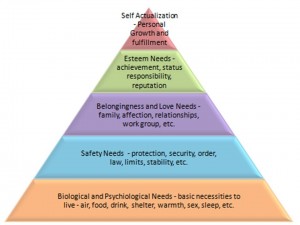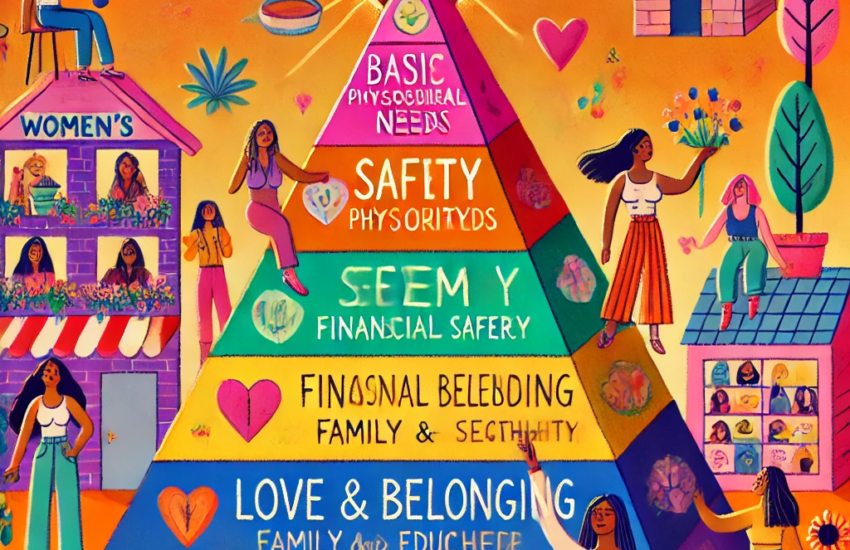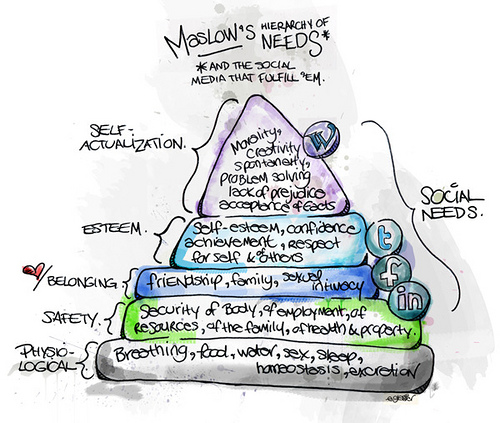In 2007, I first blogged about Maslow’s hierarchy of needs as a simple guide to user motivation and talked about community buildings such as churches and libraries. Back then I had more rigid ideas of how to design and what libraries should look like with the simplistic notion of form following function. Technology and life is ultimately more complex and more satisfying when we have discoverability and multi-functionality. More specifically when speaking about libraries, we have few focal points in communities where people feel welcome (and many people don’t feel welcome in churches) without having to spend money on fancy coffee, so why not design libraries and public spaces to make them usable for everyone? After, all design is love, not dictatorship.
That said, I love an easy way to organise ideas, and like most humans, I am a cognitive miser, once I make my mind up about something, I don’t often go back and check for another schema to organise by, job done. I used Maslow again in my Maslow’s hierarchy of social media and Maslow’s hierarchy of Chakras blogs.
We all want to be seen and heard
After a while, I would lazily link to one of my Maslow blogs each time I wanted to justify the statement that we all want to be seen and heard. Academic that I am, I can never just make a statement without having a reference to back it up, though honestly, I said it in every single blog I wrote, because I firmly believe that it is a universal truth, and not just because I heard it once on Oprah. It feels true and the only measurement of truth is how it feels, which is something else I say just as often.
Maslow was working fine and dandy for me and a few people had asked me when I was going to write a book based on my blogs so I started looking at ways to organising my blogs into book chapters. I looked at Maslow and it was then I asked myself: Ruth, where are the women? I looked in Maslow and also in my blog. I had blogged about wanting women centre stage and how women are missing from cinema and change is happening but that was it, really.
So! I wrote a web series Women: Society, Storytelling, Technology. It was difficult, as I have spent a good chunk of my life editing out the murderous patriarchal rage irritation I feel when my gender dictates the outcome of a situation, especially those times when I am not seen and heard, and when I am told a truth which does not feel true to me, even if it is about something as seemingly genderless as computer programming which to be honest, has to be anything but genderless. Even then after thousands of words about the biased nature of modern society, heavily stacked in mens’ favour, I concluded that I had been lucky and not suffered too much. I was lying, mainly to myself.
Two women in Boys Books
It was in Women as superheroes: Society, Storytelling, Technology (5), when I would normally turn to Maslow, that I realised I couldn’t, as he only used two women (Jane Addams and Eleanor Roosevelt) in his group of self-actualised people, which feminist Betty Friedan pointed out in 1963. Maslow himself said he never expected the psychology community to swallow it whole and cite it indefinitely, he wanted it to be debated. Well it wouldn’t be debated by women would it? They had been hounded out of the workplace by then to make way for men.
I finally exploded about being a woman last summer when I was not invited to my 30 year computing reunion – forgotten about because I am a woman which I melodramatically blogged about here. I will be honest and today tell you how effed over I feel living as a woman in our so called modern western society. I always imagined that one day a book of mine on technology would be in the Smart Thinkers section at Waterstones, until I was told that in publishing circles it is commonly referred to as the Boy Books section which makes me want to stand out the front of my local Waterstone’s and shout Eff you and eff your smart boy section.
No book structure or bookshop infrastructure to support me, the Google search engine has finally caught up with me and is recommending that I read articles about: Maslow’s hierarchy of needs for users. Why would I ever do that? And, Google, how will I ever learn anything new if you have access to the whole world and you telling something I first told you about 13 years ago? #mansplainer.
Patriarchy in pictures: ChatGPT and Maslow
The original image on this Maslow blog page is a photograph of a diagram I drew in my notebook when I was thinking about the question: Does it include or represent women? For Maslow picked out 44 people, only two women, on which to model his hierarchy, which has always put me in mind of the ancient Hindu Chakra system. I always intended to replace the image so when the stats jogged my memory, I asked ChatGPT to draw me an image and placed at the top here.
ChatGPT drew Maslow’s Hierarchy upside down and put physiological needs at the top where transcendence normally is. It also misspelt many of the words as it often does in pictures, but somehow, in a Gestaltian way, the sum is greater than its parts and it works and sums up Maslow’s Hierarchy of women, complete with question mark, which is why I have put this here.
Betty knows best
Women got the vote in the USA in 1920 and Maslow published his theory in 1943 during WWII. It ended in 1945 and until the end of the 1940s there was a vast amount of propaganda to get women to return to domesticity, motherhood and consumerism so the men could have their jobs back. Even Wonder Woman did the same. And, by the 1950s, it was accepted that a woman’s role was to help men nothing more.

In 1963 Betty Friedan took on Abraham Maslow:
The development of women has been blocked at the physiological level with, in many cases, no need recognised higher than the need for love or sexual satisfaction”…They were encouraged to evade human growth.
Betty Friedan, The feminine mystique (1963)
Friedan goes on to quote Maslow saying that women can only reach the level of self-actualisation through their husbands and children. I mean what is he on about? From a purely semantic point of view how can you even use the word self-actualisation and not talk about the self?
Women needs
So now that I am nice and cranky, let’s take a look at each level:
Physiological – food, water, sex, warmth, air, and shelter
Strong needs which force humans to think of little else when they are in discomfort. But not women. The pill was invented in the 1960’s so a woman had some control over her body. However, slut-shaming women who are sexually active is still a common activity today in 2020, just take a look at the press. And, each time a woman has sexual intercourse, she may be literally held holding the baby and having her whole life changed forever, to say nothing of how the media feels about the social label: the single mum.
When it comes to food, how many women do you personally know right now on a diet, restricting her food intake, in order to conform with social norms? Often starving women carry on in discomfort and think of everything and everyone.
Safety – personal or job security, employment, health, property
Do the women you know feel safe, say, walking down the street late at night? Safe knowing that people know where they live if they live alone? Safe out on a blind date? Able to have a drink in the pub without being bothered? Safe in the workplace? Not just physically but psychologically too. According to the Aristotle project the key factor for psychological safety in a team which is the confidence that the team will not embarrass, reject or punish someone for speaking up. How often are women talked over? Not seen? Not heard? Not taken seriously because of their gender? Society recognises the legitimacy of men in a way they have yet to do for women.
Social – love and affection, intimacy, belonging, friends
Connection to others is our life force. It gives our life meaning. However, there has to be a balance between giving and receiving. How many women do you know get the love, affection and appreciation they need from their family and friends? How many women feel put upon and overwhelmed by all the tasks and responsibilities they have to juggle? And analyst that I am, I have never ever heard a positive response to the question I have asked many women: How do you feel about the school playground? The one still predominantly populated by women.
Esteem
Humans need to respect themselves and have others respect them. They do this through their achievements, prestige, accomplishment, feelings, reputation, and position in communities. It is hard to achieve when you are constantly on standby for other people and you are organising other people’s days. Some people excel at this. However, the cultural devaluation of women starts at home with the mother, and then if you choose to be a child free working woman it is often disrespectfully assumed that you don’t mind picking up the slack as you have nowhere else to be.
Self-actualization – humans want to do what they were born to do, realise their potential, and feel fulfilled.
Society constantly bombards women with how they should look, behave, be, what they can and can’t do, how they should show up in the world, often small, always young and attractive. How on earth does a woman get the space to even think about what she want to do let alone how to realise her goal? Our worth is so tied up with the way we look and are perceived by others that even if we know, we still have to do it and be nice, thin, modest and use all available resources for appearance. How many women do you know who feel fulfilled?
The later levels: Cognitive, asethetic and transcendence
Maslow added two other levels: cognitive and asethetics. Film theorist Professor Laura Mulvey says, female bodies are positioned as to-be-looked-at, and these bodies are viewed from a masculinised subject position/gaze, so women become the objects which peak male curiosity and which are aesthetically pleasing as propagated by the fashion industry, marketing and the media.
Then there is the final level of transcendence which Maslow added much later to represent connecting to something bigger than oneself, a mystical, spiritual experience. This is nigh on impossible for a woman to achieve in a man’s world. Most religious organisations are power structures. In the Church of England, at best, the stories of women are few and even in Buddhism, you can be a man and a murderer like a lot of the Rinpoches were, but still reach enlightenment. A woman can never experience enlightenment. She must first reincarnate as a man.
We shouldn’t use Maslow’s hierarchy of needs again as a schema for organising user needs. It is not representative of our user population. It is not inclusive nor accessible, just two of the things any user experience designer wants for their user group even before we look at the specifics of how our users live, work and play.
Women make up 50% of the population. It is time they made up 50% of the design specifications for technology and the infrastructure of society, and this starts by collecting the correct data in the correct ratio before summarising it in a way that represents everyone.
Let’s take a good look at all our assumptions in this triangle and elsewhere and then let’s rewrite what we can to include everyone and make everything better. Design is love, not dictatorship.






